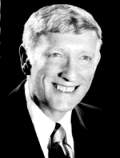The Raymond A. Weiss Lecture
 Dr. Raymond A. Weiss is a former department chairperson and head of the Division of Physical Education, Health, and Recreation at New York University. He retired in 1981, following 33 years of teaching, administration, and research. L. Jay Oliva, Provost at NYU, designated Dr. Weiss as Professor Emeritus "in recognition of his distinguished service to the University".
Dr. Raymond A. Weiss is a former department chairperson and head of the Division of Physical Education, Health, and Recreation at New York University. He retired in 1981, following 33 years of teaching, administration, and research. L. Jay Oliva, Provost at NYU, designated Dr. Weiss as Professor Emeritus "in recognition of his distinguished service to the University".
Dr. Weiss held elected offices at all levels at AAHPER, including President of AAKPE and President of the Research Council. Dr. Weiss lectured widely including internationally on the contribution of exercise to human well-being. His research included studies of physical activity for the ill and handicapped, in particular the development of a graded exercise program as a substitute for bed rest for military personnel with rheumatic fever that was the beginning of rehabilitation medicine. (Using government funding, Dr. Weiss developed a prototype doctoral program at NYU to train resources specialists in physical education for handicapped persons.) Dr. Weiss, Dr. Peter Karpovich, and Dr. Howard Rusk introduced these revolutionary recovery and rehabilitation programs to military hospitals coast to coast during World War II. Dr. Weiss was assigned to the Air Force School of Aviation Medicine, received a commendation from the Air Surgeon General, and was promoted to the rank of Captain for his role in that important research.
After completing his second doctorate at Columbia University in clinical psychology, he began a second career as a licensed psychologist, joining his wife, Dr. Rosalee G. Weiss, in private practice.
The purpose of the Raymond A. Weiss Lecture is to support a scholarly presentation by an individual in the arts and sciences who is an outstanding leader and who has made an important contribution to his or her field, and who has ties to one or more of the fields of HPERD.
Past Raymond A. Weiss Research Lecturers
- 2018: James C. Hannon, Kent State University
So much data, so little change, so what now?
- 2017: R. Scott Kretchmar, Pennsylvania State University
Play, Games, Metaphors and the Evolution of Human Intelligence
- 2016: Peter Hastie, Auburn University
Active Aubie: What Do We Really Know about our Achievement of the Physically Educated/Literate Person?
- 2015: Alison Wrynn, California State University, Fullerton
The Present Catches up to the Past: Understanding the Scientific Roots of Physical Education
- 2014: Doris Corbett, University of Northern Iowa
Reclaiming Civility and Social Justice in Physical Education and Sport
- 2013: Mary Jo Kane, University of Minnesota
An Examination of Female Athletes' Interpretations of Media Representations—A Window Into the Construction of Dual Identity & "Selling Sex" in Women's Sports
- 2012: Mary Jo Kane, University of Minnesota (CANCELLED CONVENTION)
- 2011: Daniel Gould, Michigan State University
Enhancing Youth Leadership through Sport and Physical Education
- 2010: Ross Brownson, Washington University in St. Louis
Environmental and Policy Influences on Physical Activity
- 2009: Jay Coakley, University of Colorado at Colorado Springs, Emeritus
The Implosion of Neoliberalism: New Opportunities to Reclaim Physical Activity and Sports for the Common Good
- 2008: Beverly D. Ulrich, University of Michigan-Ann Arbor
Translational Science—A Roadmap to Healthy Activity for All
- 2007: R. Scott Kretchmar, Penn State University-State College
A Research Conundrum in the 21st Century: What to Do With Meaning?
- 2006: Barbara E. Ainsworth, San Diego State University
Assessment of Physical Activity in Health and Surveillance Settings: What Have We Learned in the Past 50 Years?
- 2005: Maureen R. Weiss, University of Virginia
Understanding Youth "Physical Activity:" Social, Developmental, and Psychological Considerations
- 2004: Thomas L. McKenzie, San Diego State University
Environment, Youth, and Physical Activity
- 2003: Priscilla M. Clarkson, University of Massachusetts Amherst
The Study of Muscle Soreness—From Microtears to Microarrays
- 2002: Stephen Silverman, Teachers College, Columbia University
Research and Professional Practice: An Unrequited Love
- 2001: Wojtek Chodzko-Zajko, University of Illinois at Urbana-Champaign
Going Beyond the Physical—The Role of Physical Activity in Successful Aging
- 2000: Waneen W. Spirduso, University of Texas at Austin
Strategies of the 21st Century to Prevent Premature Physical Aging
- 1999: Carole A. Oglesby, Temple University
Significance In Science: A Kurtotic View
- 1998: Charles B. Corbin, Arizona State University
Self Esteem and Intrinsic Motivation: The Keys to Promoting Physical Activity in Youth
- 1997: Michael Pratt, Centers for Disease Control and Prevention
Physical Activity in America: Who, Why, and What Can We Do About It?
- 1996: Ronald A. Smith, The Pennsylvania State University
Women's and Men's Models of College Sport from the 19th Century to Title IX: Maternalism and Paternalism
- 1995: James F. Sallis, San Diego State University
Using Research to Promote Physical Activity in Children
- 1994: Margaret "Jo" Safrit, American University
Measureability
- 1993: Bruce Simons-Morton, National Institute for Child Health and Human
Children's Physical Activity and Fitness—Public Health Challenge
- 1992: Barbara L. Drinkwater, Pacific Medical Center, Seattle Development, NIH
Osteoporosis—The "Silent Thief" of the Golden Years